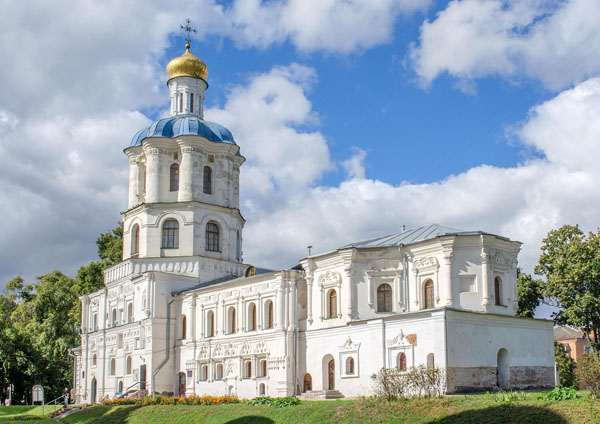Chernihiv College
Chernihiv College (Чернігівський колеґіюм; Сhernihivskyi kolegiium). An educational institution in Chernihiv that functioned in the 18th and early 19th centuries and combined elements of upper secondary education and higher education. Along with the title ‘college,’ it was also referred to as ‘the Chernihiv school,’ ‘Slavo-Latin School,’ ‘academy’ (from the 1740s on), and ‘seminary.’ The Chernihiv College itself was forerun by a simpler school, founded in Novhorod-Siverskyi by Lazar Baranovych, Archbishop of Chernihiv and Novhorod-Siverskyi, and transferred to Chernihiv in the late 17th century. The first official mention of this school is in a 1694 charter by Patriarch Adrian of Moscow confirming Teodosii Uhlytsky’s authority as Archbishop of Chernihiv and stating that numerous students were mastering ‘the skills of reading the Divine Scriptures as well as liberal arts’ there. The college’s growth at the turn of the 18th century was substantially promoted by the Archbishop of Chernihiv, Ioan Maksymovych.
Initially, the college occupied a wooden building within the premises of the Saints Borys and Hlib Monastery in Chernihiv. Its new brickwork building was constructed in 1700–1702 and subsequently enlarged several times. Outstanding for its richness of multi-style decorative elements and embossments, this building survives to the present day. Due to an acute shortage of classroom space, the college was transferred in 1776 to a brick building on the other side of the Stryzhen River left behind by the Chernihiv Cossack Colonel Pavlo Polubotok. The institution benefitted from the support of a wide circle of patrons, and in particular Hetman Ivan Mazepa. In Zertsalo ot Pisaniia Bozhestvennoho [Mirror of the Divine Scriptures], a book edited by the college’s superintendent Antonii Stakhovsky and published in Chernihiv in 1705, there is a special dedication to Mazepa stressing the part he played in the construction of the school.
The educational practices at Chernihiv College were patterned on those of the Kyivan Mohyla Academy, in their turn a replica, to a large extent, of the system implemented in Jesuit colleges (Ratio Studiorum). Its program foresaw the pupils’ consecutive mastering of grammar, poetics, rhetoric, philosophy, and theology in the respective classes. The grammar classes were mainly aimed toward instruction in Latin. Other subjects included Church Slavonic, arithmetic, singing from sheet music, catechism, German (from 1766 on), and French (from the early 1780s). Polish was taught in the college from the very start. In manuscript documents dating back to the first decades of the 18th century, the college was not infrequently called a ‘Slavo-Polish-Latin school.’ The study of rhetoric and poetics was an instrument of further improving the mastery of Latin as well as of the ethical moulding of the pupils. There is evidence pointing to the existence of a school theater run by the college.
In the second half of the 18th century some changes were introduced to the list of subjects taught in the classes of poetics and rhetoric. This list was supplemented with history, geography, mathematics, Russian, Ancient Greek (from the early 1780s), and Hebrew (from 1797 on). Instruction in philosophy was inaugurated in 1749, with Sylvester Novopolsky serving as the first ever professor of philosophy at the college. Philosophy was taught in the spirit of late scholastic Aristotelianism, as at the Kyivan Mohyla Academy. Later in the 18th century this orientation was supplanted with the Leibnizian-Wolffian system, as the latter was expounded in the textbooks by Friedrich Christian Baumeister (1709–1785). Theology, adhering to Teofan Prokopovych’s general principles, was added to the college’s curriculum in 1786. Manuals by Irynei Falkovsky and Yoakynf Karpynsky served as teaching aids. In the early 19th century, pastoral theology, canon law, church history, and hermeneutics came to be included in the basic course of study. Debates in Latin were a routine part of the lessons in the classes of both philosophy and theology.
Apart from the progeny of the clergy, the college equally enrolled Cossacks’ sons, as well as youth of other social origins. During the first decades of its existence, the college’s student body numbered around 200; by the end of the 18th century it grew to its historical maximum of over 700. The extant documentation indicates that several generations of the representatives of the regiment-level and company-level Cossack starshyna (belonging to the Tryzna, Komarovsky, Shuba, Zhurakivsky, Stakhovych, Borozna, Lyzohub, Storozhenko, and other families) completed their studies at the Chernihiv College. The college’s graduates held both ecclesiastical and secular offices.
Among other property, the college possessed a separate house serving as a bursa for its students. Both the study and everyday life in the bursa were organized following the Jesuit pedagogical practices. The college’s students had a congregation of their own and used the so-called ‘congregational dues’ to support the poorer ones among them.
The initial collection of the college’s sizable library was established by Lazar Baranovych. With time, in addition to purchasing books, this collection profited from donations coming from the local higher clergy and the college’s own teaching staff. By the beginning of the 19th century the library’s collection numbered over 4 thousand volumes.
Among the professors teaching at Chernihiv College, were such prominent churchmen as Ioan Maksymovych (later Archbishop of Chernihiv and Metropolitan of Tobolsk in Siberia), Yerofii Malytsky (later Metropolitan of Kyiv), Antonii Stakhovsky (Metropolitan of Tobolsk), Iraklii Komarovsky (Bishop of Chernihiv), Khrystofor Sulyma (Bishop of Kharkiv), and Teofan Shyianov-Cherniavsky (Bishop of Poltava). A number of the college’s professors also taught at other institutions, including the Kyivan Mohyla Academy (Narkis Harmashenko, Afanasii Korchanov), the Slavonic-Greco-Latin Academy in Moscow (Sofronii Zymynsky), and the Aleksandr Nevsky Seminary in Saint Petersburg (Isaia Hermanovsky).
The 1808 reform of religious education in the Russian Empire brought with it the transformation of Chernihiv College into an theological seminary, which received its new statute in 1817.
BIBLIOGRAPHY
Posokhova, Liudmyla. Na perekhresti kul'tur tradytsii, epokh: pravoslavni kolehiiumy Ukraïny naprykintsi XVII – na pochatku XIX st. (Kharkiv 2011)
Travkina, Olha; Levchenko, Olena; Stepanova, Olena. Chernihivskyi kolehium (Chernihiv 2012)
Liudmyla Posokhova and Serhii Vakulenko
[This article was updated in 2023.]

.jpg)